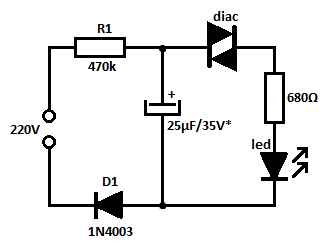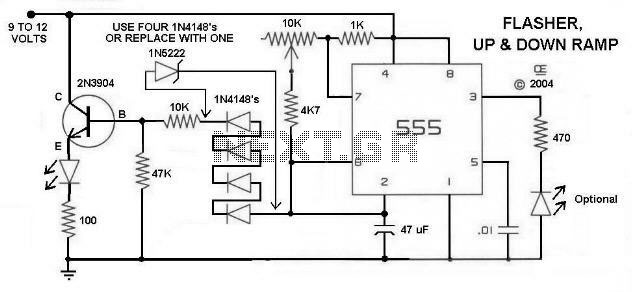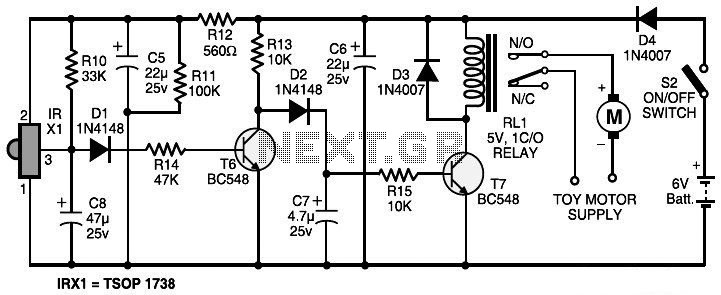
Car Reversing Horn With Flasher

This circuit activates the car horn when the vehicle is in reverse gear. It utilizes a dual timer NE556 to generate the necessary signals.
The described circuit employs a dual timer IC, specifically the NE556, which is a versatile component commonly used in timing applications. In this configuration, the NE556 is set up to detect the reverse gear activation of a vehicle. When the car is shifted into reverse, a signal is sent to the NE556, triggering it to generate a tone or beep through the car's horn.
The circuit typically includes a few additional components to ensure proper operation. A power supply, often sourced from the vehicle's battery, provides the necessary voltage to the NE556. Resistors and capacitors are used in conjunction with the timer to define the timing intervals and the frequency of the output signal, which can be adjusted to achieve the desired sound characteristics of the horn.
Input from the vehicle’s reverse light switch can be connected to the trigger pin of the NE556. This input ensures that the circuit is only activated when the vehicle is indeed in reverse, preventing accidental horn activation. The output from the NE556 can be connected to a relay, which in turn activates the car horn, allowing for higher current flow than the timer IC can handle directly.
In summary, this circuit provides a practical solution for alerting pedestrians and other drivers when a vehicle is in reverse, enhancing safety through audible warnings. The use of the NE556 timer makes the circuit reliable and efficient, suitable for automotive applications.Here is a simple circuit that starts playing the car horn whenever your car is in reverse gear. The circuit (1) employs dual timer NE556 to generate the s.. 🔗 External reference
The described circuit employs a dual timer IC, specifically the NE556, which is a versatile component commonly used in timing applications. In this configuration, the NE556 is set up to detect the reverse gear activation of a vehicle. When the car is shifted into reverse, a signal is sent to the NE556, triggering it to generate a tone or beep through the car's horn.
The circuit typically includes a few additional components to ensure proper operation. A power supply, often sourced from the vehicle's battery, provides the necessary voltage to the NE556. Resistors and capacitors are used in conjunction with the timer to define the timing intervals and the frequency of the output signal, which can be adjusted to achieve the desired sound characteristics of the horn.
Input from the vehicle’s reverse light switch can be connected to the trigger pin of the NE556. This input ensures that the circuit is only activated when the vehicle is indeed in reverse, preventing accidental horn activation. The output from the NE556 can be connected to a relay, which in turn activates the car horn, allowing for higher current flow than the timer IC can handle directly.
In summary, this circuit provides a practical solution for alerting pedestrians and other drivers when a vehicle is in reverse, enhancing safety through audible warnings. The use of the NE556 timer makes the circuit reliable and efficient, suitable for automotive applications.Here is a simple circuit that starts playing the car horn whenever your car is in reverse gear. The circuit (1) employs dual timer NE556 to generate the s.. 🔗 External reference





